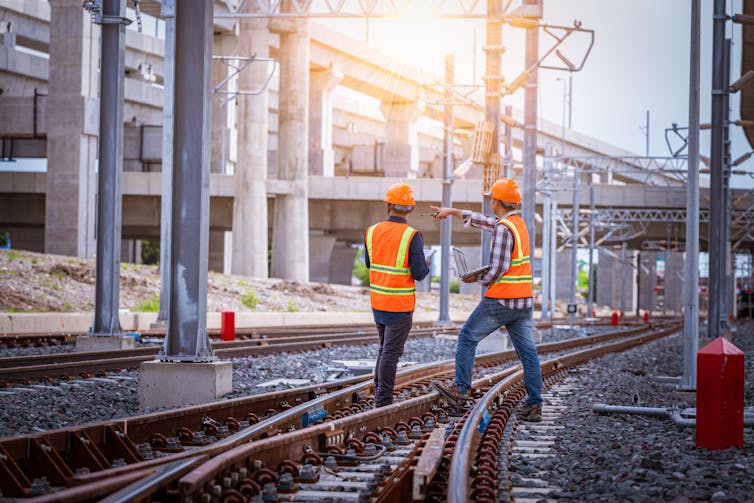
The UK’s rail service has been hit with widespread train delays and high levels of cancellations during the heatwave. The whole of the east coast line between Edinburgh and London was closed for hours on July 20 because of the heat.
So why is the heatwave causing so much havoc on the train lines? Like most construction materials, steel, which rails are made from, expands when air temperature increases. When this movement is restrained by the anchorage, which holds the rail and the sleeper (the rectangular supports for the rails) in place, internal stresses build up, and compression buckles or kinks the rail.
This buckling can cause a long piece of steel, such as a steel rail, to bend slightly or kink. Trains cannot travel over rail lines with kinks. In the US, kinks caused by the sun caused over 2,100 train derailments in the past 40 years, equivalent to around 50 derailments per year.
When air temperature reaches 30°C, rails in the sun can reach 50°C. In the UK a temporary speed restriction is imposed when rails reach this temperature because trains apply less pressure on the rails when they slow down. Some railway maintenance teams paint rails white to cool them down in summer. According to Network Rail, this can reduce the rail temperature by 5°C, to 10°C. Network Rail workers started painting the train lines several days ahead of the July heatwave.
Modern rail systems are getting better at holding rails in place. Most tracks are made up of long pieces of rail that are stretched and welded together, which helps hold them in place. This reduces the chance of buckling. When a track is made up of short rails bolted together, Network Rail leaves small gaps between each one to allow for expansion in hot weather.
Electric trains are often powered by overhead wires which can also be damaged by hot weather. Heat can make wires expand and sag. Too much sag will break the overhead line equipment. A pulley system keeps overhead wires tense and can compensate for sag.

How other nations cope
As temperatures rise to unprecedented levels, even Spanish train lines, which typically cope well in the heat, are buckling and services are being cancelled.
Continuous weld rails, which are used as standard worldwide including in the UK, are optimised to work around a given “stress-free temperature” (SFT). The higher this temperature, the hotter the rails can get without buckling.
In the UK, the SFT is 27°C, the traditional mean summer rail temperature. In the US, standard values vary between 35°C and 43°C.
If the UK SFT was higher, then the railways could operate in hotter weather because the rails wouldn’t expand so much at higher temperatures. But if the rails are made for too high an SFT then they won’t be able to cope with the colder temperatures they experience in winter. This would create tremendous stresses and the rails could shear off their anchorage.
Some countries’ railways are able to cope with such high temperature variation by using solid concrete slabs to contain the higher forces created. But slab tracks costs approximately four times as much to install as standard ballasted track.
Climate change means many countries’ railways will more often reach temperatures they were not designed to cope with, threatening public transport on a scale never seen before. We just saw the highest temperature ever recorded in the UK at 40.3°C, well above the previous daily high of 38.7°C in 2019.
During the construction of HS2, the new highspeed railway being built between London, Manchester and Leeds, bridges and overhead wires have been fitted with sensors to collect data about weather including the air temperature. This data will be used to create the digital twins of HS2, allowing for a new type of maintenance that can predict high temperatures and other types of disruptive weather.
A digital twin is a digital representation of the railway network. This would allow engineers to simulate future scenarios for the UK rail network and predict what might happen if high temperatures are forecast, and be able to take preventative action in advance. This could be one way to prevent some of the huge cancellations seen in the recent UK heatwave.
Kangkang Tang, Senior Lecturer in Civil and Environmental Engineering, Brunel University London
This article is republished from The Conversation under a Creative Commons license. Read the original article.